The majority of the suggested solutions, assigned for the night lighting of the model, secure its contour lighting. The contour lighting is secured by the installed light-illuminating diodes and the light-illuminating strips. The gadget HeliStrobe is assigned for the external lighting of the helicopter model. It means that the light-illuminating elements are installed in such a way so that the illuminating light gets reflected from the body and from the revolving rotor. When the body of the model is lighted from the outside, the model at night looks similarly as during the day-time. Seeking for more vivid lighting of the body of the helicopter, the light-illuminating elements are moved to the sides of the body with the help of the masts. The gadget HeliStrobe synchronizes winking of the light-illuminating elements with the rotor revolving; thus, the rotor of the helicopter looks like a solidified figure. The shape of the figure to be illuminated is selected from several preliminary set variants. The blades of the main rotor should obligatorily be of the while color
Choosing of the light-illuminating diodes
The bright LED's are used as the light-illuminating elements. The recommended total power of the diodes should be at least 10 W. Usage of the light-illuminating diodes of different colors changes the color of illumination of the rotor and of the body of the model. The ready-made blocks of the light-illuminating diodes, assigned for the fixed voltage, can be used. However, some of these blocks produce illumination, which is too dim, in spite of the fact that sufficiently powerful diodes are contained in them.

As feeding of the diodes from the gadget HeliStrobe is impulsive, the current, which passes via them, can be increased. Seeking for increase of the current, it is possible to use feeding from the battery with higher tension than it is indicated in the light-illuminating elements. For example, the section of the light-illuminating diodes, meant for 12 V, can be fed from the battery of the Li-Po accumulators, consisting of 4 sections (15-17V). As regards the gadget HeliStrobe, the permissible tension of feeding is 7-20V. In most cases the resistors, installed in the lighting elements, provided with the light-illuminating diodes, may be substituted. For example, the resistors, installed on such tapes, may be substituted by the nil ones (white color LED's, 11.1V Li-Po battery):

By increasing the current, You will increase brightness of illumination of the diodes, but You will hasten their expiry date. If the current is too high, the light-illuminating diodes will firstly get overheated and afterwards will burn out. Extra cooling is necessary for certain powerful light-illuminating diodes. Such light-illuminating diodes can be tightly pressed to the metal components of the landing skid, which will diffuse heat. Seeking for better heat dissipation, it is necessary to grease the connection with the heat-conducting liniment or with the special glue or to use the heat-conducting pads.
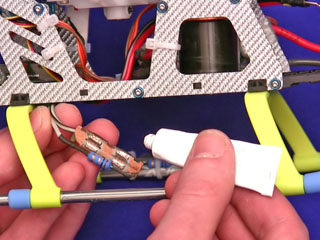
The information about connection of powerful light-illumination diodes via resistance is submitted in the manual of the gadget. It is more convenient to purchase the LED's in special shops, which sell radio-components.
Manufacturers of High Power LEDs:
http://www.philipslumileds.com/products/luxeon
http://www.acriche.com/en
http://www.osram-os.com/osram_os/EN
http://www.everlight.com
http://www.edison-opto.com.tw
http://led-manufacturer.en.alibaba.com/
Using panels of 48 Flat Top diodes with 5 mm diameter was found to be the most convenient and economic solution.

Dimensions - 161x12x8 mm, weight - 17 g. Power is supplied to the diodes via the single resistor.
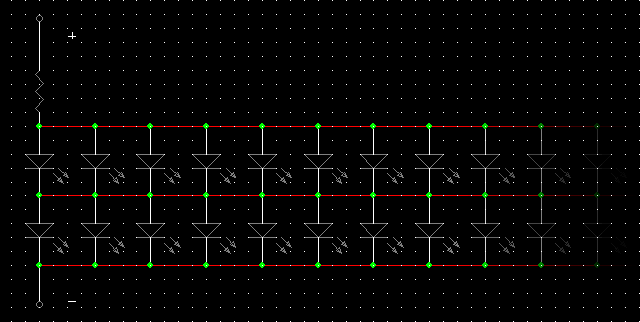
If the LEDs are fed from 7.2-8.4V battery, they are connected as follows:
White - two diodes are connected in series, the resistance 0.2 Ohm, the pulse current 2.4A, the electric power 18W.
Warm white - two diodes are connected in series, the resistance 0.0 Ohm, the pulse current 2.4A, the electric power 20W.
Purple - two diodes are connected in series, the resistance 0.47 Ohm, the pulse current 2.4A, the electric power 17W.
Blue - two diodes are connected in series, the resistance 0.2 Ohm, the pulse current 2.4A, the electric power 19W.
Green - two diodes are connected in series, the resistance 0.2 Ohm, the pulse current 2.4A, the electric power 19W.
Yellow - three diodes are connected in series, the resistance 1.2 Ohm, the pulse current 1.6A, the electric power 10W.
Orange - three diodes are connected in series, the resistance 1.0 Ohm, the pulse current 1.6A, the electric power 10W.
Red - three diodes are connected in series, the resistance 1.2 Ohm, the pulse current 1.6A, the electric power 10W.
Visually, the brightest colours are white, blue, and green. Ultra-violet radiation may be used together with the fluorescent blades. It is advisable to install two panels on each side of the helicopters, attributed to the class 60-90. For feeding, a two-section lithium battery of at least 1000 mA/h capacity should be used. Do not connect the panels to the battery in absence of HeliStrobe device, because they will burn out soon. To the diodes of the said panels, currents of maximal values are applied and the supply should be pulse (it is ensured by HeliStrobe device).
Improvements
Seeking for illumination of the main rotor of the helicopter from above, it is necessary to fix the block of LED's over it.The feeding wires are let through the hollow axle with the purpose of installing the lighting elements over the main rotor of the helicopter. The brush collector is installed from below. The brushes of a small electric motor are used. The junction, meant for connection of the LED, is installed from above. The light-illuminating diodes, installed above the rotor, are fed from one of the outlets of the device HeliStrobe (parallel connection to one of the lateral lighting elements).
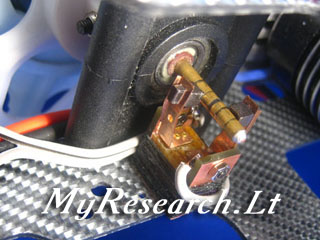
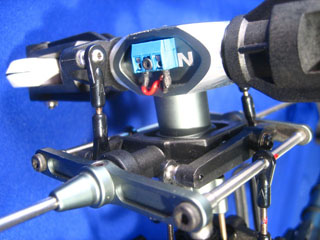

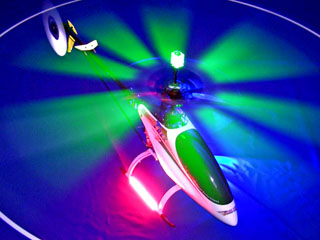
It is also possible to use the blades with the installed light-illuminating diodes so as to observe the plane of rotation of the screw propeller in the overturned condition.
The demonstrative video-clip provides several examples of illumination and twinkling of the parts, pasted over with the light-reflecting film. The source of the twinkling light was fixed on the video-camera.
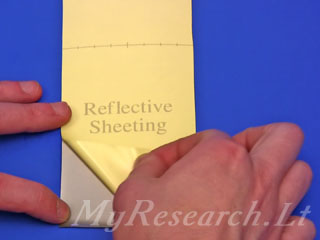
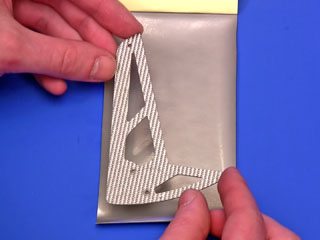




The demonstrative clip provides the view of the rotor of one of the helicopters, which is illuminated with the red-green symbol of "radioactivity". It is done in the following way. The green light-illuminating diodes are connected to the left canal of the HeliStrobe from the left and the red light-illuminating diodes - from the right. The green light-illuminating diodes are connected to the right canal of the HeliStrobe from the right and the red light-illuminating diodes - from the left. The double-color figure is achieved as the result of signals, coming to the left and right canals by turns.
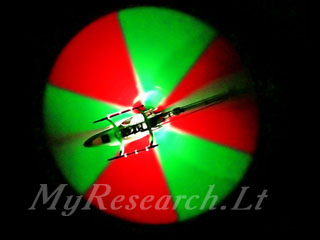
History of making the gadget HeliStrobe
The first version of the gadget foresees usage of the optical sensor for synchronization with the rotor. The illuminated figure used to comply with the view on the disc, which was fixed on the gear. The number of strips on the disc was divisible by the transmission number for the tail rotor; the tail rotor also looks like a solidified figure for this reason.

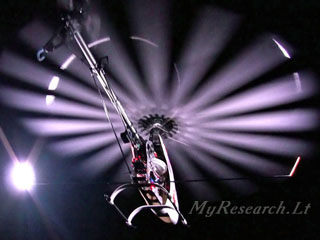
The second version foresees usage of the xenon lamps. The flash of the xenon lamp is very short; thus, the blades look like as if they are set in the place. The xenon lamps should be thoroughly handled; high tension should be available.
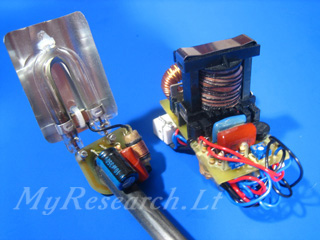

The third version foresees illumination of the rotor with many-colored light-illuminating diodes. The light-illuminating diodes revolve together with the rotor. The three-phase generator of the current, fixed on the shaft of the main rotor, used to generate feeding for the light-illumination diodes. The number of the colored petals at the illuminated rotor is equal to half of the number of magnets in the generator.

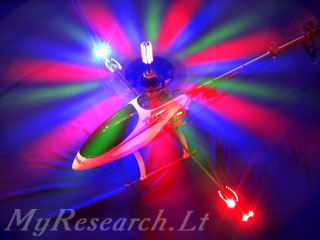
The micro-processor device serves as the fourth version. Small weight is typical of this version; it provides the possibility of selecting various figures, assigned for illumination of the rotor.
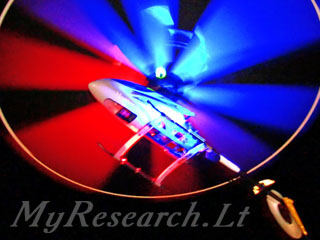
All the above-specified versions of the gadget have been patented, but the non-commercial reiteration of the schemes by private persons is welcomed.
Video:

